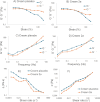Antibacterial Creams Containing Cationic Carbosilane Dendrimers for Wound Treatment
- PMID: 40809105
- PMCID: PMC12340762
- DOI: 10.1021/acsapm.5c01718
Antibacterial Creams Containing Cationic Carbosilane Dendrimers for Wound Treatment
Abstract
Skin wounds are an important factor in developing bacterial infection, especially for chronic wounds. In this case, the exposure to long traditional antibacterial-based treatments can lead to the appearance of resistance to these drugs. This situation makes the search for alternatives to attack these infections essential, as it is the use of cationic multivalent systems. Here, we discussed the antibacterial and biological properties of different cationic carbosilane (CBS) dendrimers against () and () as models of Gram-positive and Gram-negative bacteria, respectively. Dendrimers are a type of multivalent molecule with a well-defined structure. The CBS dendrimers used in this work differ in several modifications that affect the hydrophobic/hydrophilic balance, which is very relevant to achieve bactericidal activity. These structural changes are the position of a short alkyl chain, in the internal dendritic structure or on the outer ammonium groups, the presence of a polyethylene glycol (PEG) chain instead of a cationic function, or in the vicinal moieties of the cationic functions, sulfur atoms or sulfone units. The studies allowed the selection of some dendrimers, all of them with the inner long chain and trimethylammonium (-NMe3 +) groups, as active ingredients of a topical cream (water in oil, W/O). The antibacterial and biological properties of the creams were also tested against bacteria because it is the most common pathogen involved in skin infections. We observed different abilities of the dendrimers to be released from the cream, depending on the dendrimer structure, and as a consequence, different antibacterial properties of the creams. Finally, an analysis of the physicochemical properties of the best formulation was also done.
Keywords: antibacterial; carbosilane dendrimer; quaternary ammonium; skin wound; topical cream.
© 2025 The Authors. Published by American Chemical Society.
Figures








Similar articles
-
Prescription of Controlled Substances: Benefits and Risks.2025 Jul 6. In: StatPearls [Internet]. Treasure Island (FL): StatPearls Publishing; 2025 Jan–. 2025 Jul 6. In: StatPearls [Internet]. Treasure Island (FL): StatPearls Publishing; 2025 Jan–. PMID: 30726003 Free Books & Documents.
-
Systemic pharmacological treatments for chronic plaque psoriasis: a network meta-analysis.Cochrane Database Syst Rev. 2021 Apr 19;4(4):CD011535. doi: 10.1002/14651858.CD011535.pub4. Cochrane Database Syst Rev. 2021. Update in: Cochrane Database Syst Rev. 2022 May 23;5:CD011535. doi: 10.1002/14651858.CD011535.pub5. PMID: 33871055 Free PMC article. Updated.
-
Systemic pharmacological treatments for chronic plaque psoriasis: a network meta-analysis.Cochrane Database Syst Rev. 2020 Jan 9;1(1):CD011535. doi: 10.1002/14651858.CD011535.pub3. Cochrane Database Syst Rev. 2020. Update in: Cochrane Database Syst Rev. 2021 Apr 19;4:CD011535. doi: 10.1002/14651858.CD011535.pub4. PMID: 31917873 Free PMC article. Updated.
-
Dressings and topical agents for treating pressure ulcers.Cochrane Database Syst Rev. 2017 Jun 22;6(6):CD011947. doi: 10.1002/14651858.CD011947.pub2. Cochrane Database Syst Rev. 2017. PMID: 28639707 Free PMC article.
-
Dressings and topical agents for treating venous leg ulcers.Cochrane Database Syst Rev. 2018 Jun 15;6(6):CD012583. doi: 10.1002/14651858.CD012583.pub2. Cochrane Database Syst Rev. 2018. PMID: 29906322 Free PMC article.
References
-
- Tognetti L., Martinelli C., Berti S., Hercogova J., Lotti T., Leoncini F., Moretti S.. Bacterial skin and soft tissue infections: review of the epidemiology, microbiology, aetiopathogenesis and treatment: a collaboration between dermatologists and infectivologists. J. Eur. Acad. Dermatol. Venereol. 2012;26:931–941. doi: 10.1111/j.1468-3083.2011.04416.x. - DOI - PubMed
-
- Karimkhani C., Dellavalle R. P., Coffeng L. E., Flohr C., Hay R. J., Langan S. M., Nsoesie E. O., Ferrari A. J., Erskine H. E., Silverberg J. I., Vos T., Naghavi M.. Global Skin Disease Morbidity and Mortality: An Update From the Global Burden of Disease Study 2013. JAMA Dermatol. 2017;153:406–412. doi: 10.1001/jamadermatol.2016.5538. - DOI - PMC - PubMed
LinkOut - more resources
Full Text Sources

